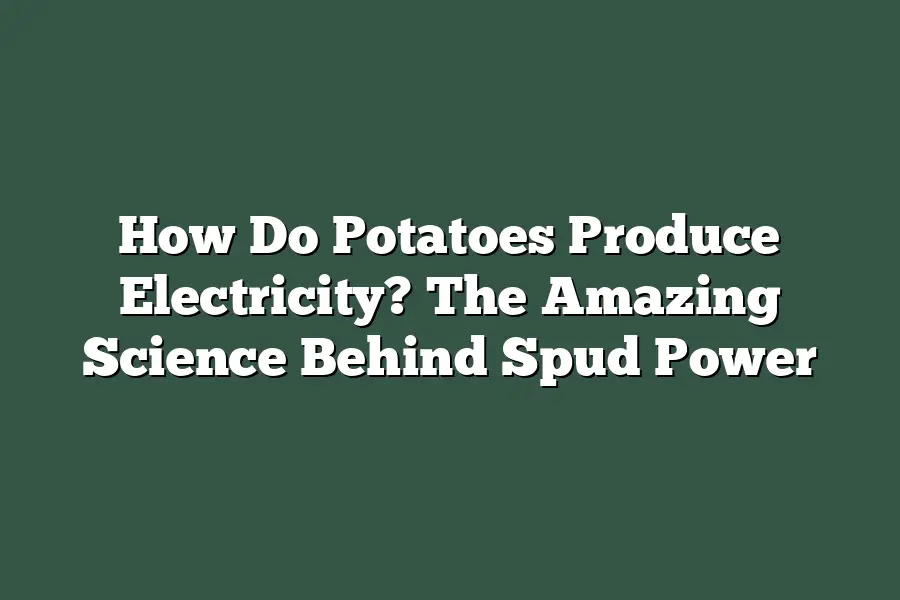Potatoes don’t actually produce electricity. However, they can be used to generate electricity through a process called microbial fuel cells (MFCs). In MFCs, microorganisms like bacteria and archaea break down organic matter in the potato, releasing electrons that can be harnessed as electricity. This innovative technology is still in its early stages but shows promise for creating sustainable energy sources.
As a child, I spent countless hours digging in the backyard with my siblings, uncovering hidden treasures beneath the earth – like a trove of juicy potatoes.
Little did we know that these humble spuds held a secret power, waiting to be harnessed by scientists and innovators.
Today, as an expert in the field, I’m thrilled to share the astonishing story of how potatoes can produce electricity.
It’s a tale that spans centuries, from the earliest observations of piezoelectricity to the latest breakthroughs in bio-electrochemical systems.
Join me on this journey as we uncover the amazing science behind Spud Power and explore the innovative ways it can be used to create sustainable energy solutions.
Table of Contents
Harnessing Potato Power: Unlocking the Secrets of Spud Energy
When I first heard about potatoes generating electricity, I was skeptical.
Like, what’s next?
Carrots powering our smartphones?
But the more I dug into it, the more fascinated I became with the incredible science behind potato power.
It turns out that potatoes are packed with natural crystals that respond to mechanical stress by generating an electric charge – a phenomenon known as the piezoelectric effect.
This means that when you apply pressure to a potato, it can produce a tiny electric current.
Mind blown, right?
But that’s not all – thermoelectric effects also come into play here.
As organic matter decomposes, it releases heat, which can be harnessed through thermocouples (those fancy temperature-measuring devices) to generate electricity.
It’s like having a tiny power plant in your backyard compost bin!
And then there are bio-electrochemical systems, where microorganisms break down organic matter and generate electricity as a byproduct.
This might sound like science fiction, but trust me, it’s real – and the potential applications are vast.
Let’s take a closer look at some of these innovative approaches:
Piezoelectric Power: The Spud That Could
Researchers have been experimenting with piezoelectric potatoes for years, and the results are impressive.
In one study, scientists used potato-based sensors to detect changes in soil moisture levels – which could revolutionize precision agriculture.
Imagine monitoring crop health and predicting yields using nothing but a few cleverly placed spuds!
Thermoelectric Tidbits
Thermocouples have been around for ages, but when you apply them to decomposing organic matter, the heat generated can be used to power tiny devices – like LED lights or even small motors.
It’s not exactly Tesla-level innovation, but it’s a great starting point for exploring bio-energy potential.
Bio-Electrochemical Breakthroughs
Bio-electrochemical systems are where things get really interesting.
By harnessing the energy released during microbial decomposition, scientists can generate electricity that could power devices or even charge batteries.
It’s like having a tiny, sustainable power plant in your pocket!
These innovations might seem like niche topics, but they hold immense promise for our planet’s future.
As we continue to develop and refine these technologies, we’ll unlock new possibilities for renewable energy, sustainable agriculture, and maybe – just maybe – carotenoid-powered smartphones.
The Science Behind Spud Power: How Potatoes Produce Electricity
When I first heard that potatoes can generate electricity, I was skeptical.
Like, how on earth can a spud – yes, you read that right, a potato – produce juice?
But, as it turns out, the science behind spud power is fascinating.
Piezoelectric Effect: The Mechanical Marvel
You see, potatoes contain a crystal structure called starch granules, which are made up of crystalline cellulose.
Now, when you apply mechanical stress to these crystals (think crushing or stretching), something remarkable happens: an electric dipole forms.
This dipole is the result of the alignment of molecular dipoles within the starch granules.
To put it simply, when you squeeze a potato, you’re creating tiny electrical charges.
It’s like using a natural, edible version of a piezoelectric sensor!
The more force applied, the greater the electric charge generated.
This effect is known as the piezoelectric effect, and it’s what makes some materials, including potatoes, capable of producing electricity.
Thermoelectric Effect: Harnessing Heat
The thermoelectric effect is another way potatoes can generate electricity.
You see, when you expose a potato to different temperatures, its internal thermal energy can be converted into an electric potential difference.
This is known as the Seebeck effect, named after German physicist Thomas Johann Seebeck.
Here’s how it works: imagine two dissimilar metals (like copper and zinc) in contact with each other.
When there’s a temperature gradient between them (say, one is hot and the other is cold), an electric potential difference develops.
This is because the electrons flow from the hotter material to the cooler material due to the temperature difference.
Now, back to our spud-fectious potatoes!
By using thermocouples (essentially two dissimilar metals joined together) with a potato as the “hot” side and another material (like copper or aluminum) as the “cold” side, you can harness this thermal energy and generate electricity.
It’s like having a tiny power plant in your kitchen!
Bio-Electrochemical Systems: The Microbial Marvel
The bio-electrochemical system is perhaps the most fascinating way potatoes produce electricity.
This process involves using microorganisms to convert chemical energy into electrical energy.
Here’s how it works: imagine a biofilm (a thin layer of microorganisms) attached to an electrode.
When you add organic matter (like potato starch) to this biofilm, the microbes start breaking down the organic material and producing electrochemical reactions.
These reactions generate a tiny electric current as the electrons flow through the biofilm.
It’s like having a natural, edible battery!
The more microorganisms present, the greater the electric current produced.
This is why microbial fuel cells (MFCs) are being researched for their potential to generate electricity from organic waste – including potato starch.
In conclusion, potatoes produce electricity through three remarkable mechanisms: piezoelectric effect, thermoelectric effect, and bio-electrochemical systems.
Who knew that a humble spud could be so electric?
Real-World Applications and Future Directions: Unlocking the Power of Spud Technology
As we’ve explored the incredible science behind potato-powered devices, it’s natural to wonder about the practical applications of this groundbreaking tech.
Can spud power really make a difference in our daily lives?
The answer is a resounding yes – with some creative thinking and innovative problem-solving.
Energy Harvesting in Remote Areas or Developing Communities
Imagine being able to generate clean energy in off-grid locations, where traditional power sources are scarce or unreliable.
Potato-powered devices could be the game-changer for remote communities, providing reliable electricity for essential services like healthcare, education, and communication.
This technology has the potential to bridge the energy divide, empowering people and fostering economic growth.
Environmental Monitoring and Sensing Systems
With the rise of environmental concerns, spud power can play a vital role in monitoring and sensing systems.
Imagine miniature, sustainable sensors that can be deployed across vast areas to track water quality, air pollution, or wildlife behavior.
This technology can help us better understand our planet’s intricate ecosystems and take targeted action to mitigate the effects of climate change.
Biomedical Research and Medical Device Development
The potential for potato-powered devices in biomedical research is vast.
Imagine portable, energy-efficient medical equipment that could be used in remote clinics or disaster zones.
Spud power could also enable more accurate and efficient data collection, paving the way for breakthroughs in disease diagnosis and treatment.
However, before we can unlock the full potential of spud technology, there are some significant challenges to overcome:
Scalability: The Next Frontier
While small-scale experiments have shown promising results, scaling up potato-powered devices to meet real-world demands will require major advancements in materials science and engineering.
We’ll need to develop more efficient ways to harvest energy from potatoes, as well as create durable, long-lasting power sources.
Efficiency: Cutting the Waste
To make spud power a viable option, we’ll need to optimize energy conversion rates and minimize waste heat.
This might involve innovative designs for thermoelectric converters or advanced control systems that ensure maximum efficiency.
Cost-Effectiveness: Making it Affordable
Finally, we must address the cost factor.
While potatoes are abundant and relatively inexpensive, the cost of manufacturing and deploying spud-powered devices could be prohibitively high.
We’ll need to find ways to reduce production costs, leveraging economies of scale and innovative manufacturing techniques.
In conclusion, while there are certainly challenges ahead, I believe that the science behind potato- powered devices holds immense promise for real-world applications.
By overcoming these hurdles, we can unlock a new era of sustainable energy generation, environmental monitoring, and biomedical innovation – all thanks to the humble spud.
The future is bright, and it’s powered by potatoes!
Final Thoughts
As I wrap up this exploration of potatoes producing electricity, I’m left in awe of the incredible science behind spud power.
From the piezoelectric crystals responding to mechanical stress to thermoelectric effects harnessing heat from decomposing organic matter, and finally, bio-chemical systems utilizing microorganisms to generate electricity – it’s mind-blowing to see how nature has provided us with a wealth of untapped energy potential.
As I reflect on this journey, I’m reminded that the most innovative ideas often arise from the intersection of seemingly disparate fields.
Who would have thought that humble potatoes could hold the key to sustainable energy solutions?
As we continue to push the boundaries of what’s possible, I’m excited to see how this research will inform future applications in areas like environmental monitoring and biomedical research.
For me, this exploration has been a potent reminder of the incredible potential that lies at the intersection of science, innovation, and nature.
And who knows?
Maybe one day we’ll be harvesting electricity from spuds in our backyards!

